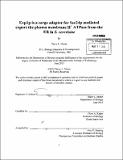| dc.contributor.advisor | Chris A. Kaiser. | en_US |
| dc.contributor.author | Morse, Darcy L. (Darcy Lee) | en_US |
| dc.contributor.other | Massachusetts Institute of Technology. Department of Biology. | en_US |
| dc.date.accessioned | 2013-09-24T19:38:15Z | |
| dc.date.available | 2013-09-24T19:38:15Z | |
| dc.date.copyright | 2013 | en_US |
| dc.date.issued | 2013 | en_US |
| dc.identifier.uri | http://hdl.handle.net/1721.1/81032 | |
| dc.description | Thesis (Ph. D.)--Massachusetts Institute of Technology, Dept. of Biology, 2013. | en_US |
| dc.description | In title on title page, double-underscored "+" appears as superscript. Cataloged from PDF version of thesis. | en_US |
| dc.description | Includes bibliographical references. | en_US |
| dc.description.abstract | The secretory pathway in S. cerevisiae is responsible for the folding, modification and delivery of plasma membrane and secreted proteins. The secretory pathway consists of an ordered series of organelles including the endoplasmic reticulum (ER), Golgi, endosome and vacuole. In the ER, properly folded proteins are separated from misfolded and ER resident proteins and packaged into COPII coated vesicles for transport to the Golgi network and ultimately to the cell surface. How cargo proteins are distinguished from ER resident proteins and loaded into vesicles remains unclear for many cargo proteins. To facilitate our study of the mechanism of protein sorting in the ER, we selected the plasma membrane H+ ATPase PMAJ as a model cargo protein. Pmalp is essential for creating an electrochemical gradient across the plasma membrane required for nutrient uptake and maintenance of cytosolic pH and accounts for ~25% of the total plasma membrane proteins. We previously reported that Pmalp requires the Sec24p paralog Lstlp for efficient export from the ER. Here we report the identification of a novel gene, EXP1 (E̲R ex̲port of P̲malp), which when overexpressed can restore localization of Pmalp to the plasma membrane in an ist1[delta] strain. Strains carrying a deletion of EXP1 grow normally, but an ist1[delta] exp1[delta] double mutant is inviable, displaying a severe Pmalp trafficking defect. EXP1 encodes a 17 kDa integral membrane protein which cycles between the ER and Golgi and physically interacts with both Sec24p and Pmalp Taken together our data suggests that Pmalp exits the ER via two independent pathways. Lstlp mediates the primary route while ExpIp is required as a cargo adaptor for the secondary Sec24p mediated route. We also present data from a screen of S. cerevisiae essential genes under the control of a doxycycline regulatable promoter for genes required for trafficking of the cell wall mannoprotein Ccwl4p. One gene identified, PGA2, shares physical characteristics with EXP1 raising the possibility that Pga2p may function as a cargo adaptor for ER export. We show that Pga2p is an ER localized integral membrane protein required for ER export of Ccwl4p, CPY and invertase. | en_US |
| dc.description.statementofresponsibility | by Darcy L. Morse. | en_US |
| dc.format.extent | 216 p. | en_US |
| dc.language.iso | eng | en_US |
| dc.publisher | Massachusetts Institute of Technology | en_US |
| dc.rights | M.I.T. theses are protected by
copyright. They may be viewed from this source for any purpose, but
reproduction or distribution in any format is prohibited without written
permission. See provided URL for inquiries about permission. | en_US |
| dc.rights.uri | http://dspace.mit.edu/handle/1721.1/7582 | en_US |
| dc.subject | Biology. | en_US |
| dc.title | Exp1p is a cargo adaptor for Sec24p mediated export the plasma membrane H+̳ ATPase from the ER in S. cerevisiae | en_US |
| dc.type | Thesis | en_US |
| dc.description.degree | Ph.D. | en_US |
| dc.contributor.department | Massachusetts Institute of Technology. Department of Biology | |
| dc.identifier.oclc | 857791060 | en_US |
